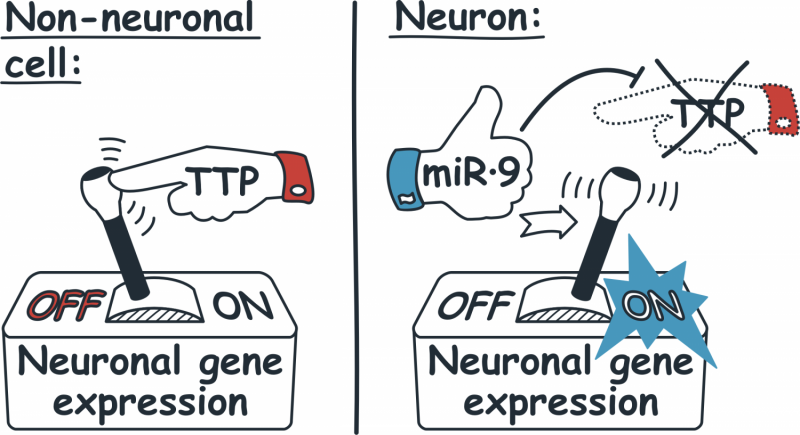How to rule a gene galaxy: A lesson from developing neurons

The human organism contains hundreds of distinct cell types that often differ from their neighbours in shape and function. To acquire and maintain its characteristic features, each cell type must express a unique subset of genes. Neurons, the functional units of our brain, develop through differentiation of neuronal precursors, a process that depends on coordinated activation of hundreds and possibly thousands of neuron-specific genes.
A new study published in Nature Communications by researchers from the MRC Centre for Developmental Neurobiology (MRC CDN) at IoPPN, carried out in collaboration with the Tian lab at the Rutgers New Jersey Medical School (USA), unravels how this synchrony is achieved at the molecular level. The researchers found that many RNA messengers encoding neuronal proteins contain specialized sequences that can promote their destabilization in the presence of an RNA-binding protein called tristetraprolin, or TTP. This protein is expressed at relatively high levels in proliferating precursors and non-neuronal cells but down-regulated in developing neurons by a brain-enriched regulatory RNA called miR-9. The TTP/miR-9 pair functions as a switch limiting unscheduled accumulation of neuronal messengers in non-neuronal cells and ensuring coordinated accumulation of these molecules in neurons.
"Coherent regulation of multiple genes can pose substantial logistical problems, akin running a successful business employing thousands of people or controlling the vast Galactic Empire from the Star Wars movies" remarks Dr. Eugene Makeyev, a senior author of the study from the MRC CDN. "Our work suggests that fine-tuning messenger stability is an important mechanism orchestrating gene expression changes during normal brain development".
Defective regulation of messenger stability, cellular localization and translation into corresponding protein products often leads to serious medical conditions including neurodegenerative diseases and cancer. A subset of the TTP/miR-9 target genes have been previously linked to these disorders and it will be important to determine whether deregulation of TTP or/and miR-9 plays a causative role in such pathological contexts. Moreover, by uncovering a hitherto unknown mechanism mediating neuronal differentiation, the study by Makeyev and co-authors should facilitate development of novel cell replacement therapies for neurological and neurodegenerative diseases.
"Natural renewal of neurons in the adult brain is notoriously inefficient and it likely becomes virtually non-existent as we grow older. With a continued increase in the average life expectancy neuron replacement might become a common medical procedure at some point in the future. Luke Skywalker and his aging father would certainly relate to this idea".
More information: A post-transcriptional mechanism pacing expression of neural genes with precursor cell differentiation status, Nature Communications 6, Article number: 7576 DOI: 10.1038/ncomms8576



















